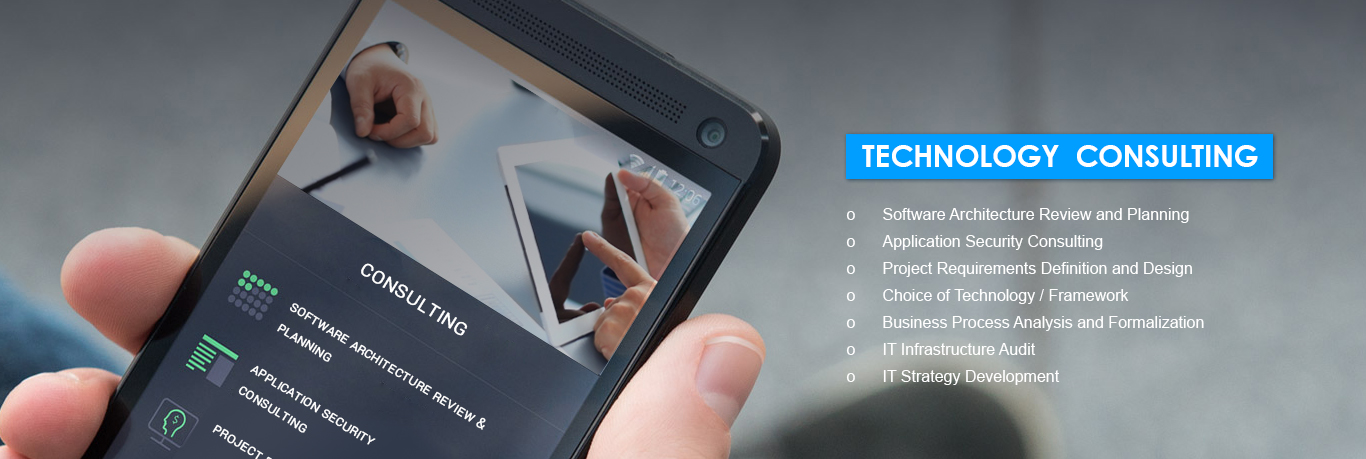-
Technology ConsultingTechnology Consulting
-
Custom Software DevelopmentCustom Software Development
-
Software Product DevelopmentSoftware Product Development
-
Mobile OfferingsMobile Offerings
-
CMS(Content Management Solutions)&Ecommerce OfferingsCMS(Content Management Solutions)&Ecommerce Offerings
-
SEO & Internet MarketingSEO & Internet Marketing
-
Maintenance and SupportMaintenance and Support
-
Finance and AccountingFinance and Accounting
- Technology
- Tools & Techniques
- Why Acrossys
- Solutions
As an essential and integral part of your business strategy, your IT infrastructure should serve as a strong central nervous system that interacts with your employees, clients, suppliers, media and management with smart investments and long-term benefits.
From resolving specific IT-related issues to strategic business transformation fueled by IT, we deliver technology consulting services to companies across multiple domain areas. We are aimed to become your reliable IT partner with the functional know-how, detailed understanding, resources and in-depth expertise to ensure that your business, management and staff use Information Technology efficiently, effectively and in-line with your goals and business challenges.
Acrossys Consulting Services
With experience in software development, implementation, quality assurance and software support since 1998, our advisory services are built on a deep understanding of all business and functional requirements as well as ambiguous nuances of business workflows.
We offer comprehensive software services that cover the full development and implementation cycle of your IT project including a full range of consulting services.
- IT Infrastructure Audit
- IT Strategy Development
- Software Architecture Review and Planning
- Application Security Consulting
- Project Requirements Definition and Design
- Choice of Technology / Framework
- Business Process Analysis and Formalization
Our technological expertise and in-depth understanding of business processes let us tackle each complex situation that the business will encounter during each stage of the business life cycle. The main goal and expected result of such engagements is business operations optimization, better cost and resource efficiency. These stages include:
Start of a New Business
Acrossys provides critical business intelligence and reliable market analysis that is vital for business decision making at this stage. This includes professional audit of hardware and software environment in correlation with the business objectives.
Business Expansion
Our main objective is to create an optimum and highly efficient operational process through fully integrated business automation. This includes integration with legacy infrastructure as well as the handling of other complex business modules including logistics, equipment tracking, cost strategies and marketing investments.
On-going Operations
Our consultancy services help businesses create a highly cost-efficient outsourcing business process to enable the company to concentrate on their core competence and primary objectives while delegating non-core IT processes. Our consultants will help you select the most appropriate engagement model to fit your business needs.

Software Architecture Review and Planning
Software Architecture Reviews represent one of the most important approaches for...

Application Security Consulting
Application security (short: AppSec) encompasses measures taken throughout the c...

Project Requirements Definition and Design
Defining IT project requirements is a crucial task when initiating new projects....

Choice of Technology / Framework
Every project needs a very meticulous planning and choice of technology should b...

Business Process Analysis and Formalization
Business analysis is a research discipline[1] of identifying business needs and ...

IT Infrastructure Audit
Five key steps in audit-proofing your infrastructure ...

IT Strategy Development
IT Stratergy must always be Results-Driven Strategy. Typical IT plan should tak...
- Software Architecture Review and Planning
Software Architecture Reviews represent one of the most important approaches for introspecting software design. The best way for introducing such assessments is to establish regular evaluation workshops in all iterations. Architects and designers will review the software architecture focusing on internal qualities such as unavailability of dependency cycles and quality attributes such as performance or modifiability. If they find any issues, they will define action items and means for getting rid of the challenges.
Unfortunately, many architecture reviews are initiated very late. This makes problem detection and architecture refactoring much more complex. Nonetheless, such architecture reviews are always a good solution to get rid of architectural problems, especially when the organization could not handle such issues successfully in the development project. These reviews should have a clear scope. Otherwise, the review will take place for large time frames which is not acceptable in most cases. Scoping in this context means to define a main objective of the review as well as 2-3 key areas where potential problems supposedly lurk in the guts of the design. The result of such a “large” review should be a document with key findings, e.g., weaknesses and strength of the architecture. However, it should not only contain the weaknesses but also appropriate solutions for addressing these weaknesses. Some review methods don’t consider solutions mandatory in such a report.
Such a report should reveal the following structure:
- Scope of the review and review method
- Documents (project documents) and information used (for example: interviews, test plans, source code, demos)
- Executive Summary
- Overview of the software architecture under review
- Findings and Recommended Solutions
- Summary

- Application Security Consulting
Acrossys has a customer oriented approach and can offer an all-in solution tailored to the needs and request for any company.
For every security project we follow the next steps:
- At the start of the security project we analyze the actual and future needs concerning security with the customer.
- With this analysis we propose the customer a specific solution.
- In the next step our security experts deploy the solution, as described in the previous phase.
- After deploying the security project, our experts provide support where the customer needs it.

- Project Requirements Definition and Design
Defining IT project requirements is a crucial task when initiating new projects. We follow the series of steps that every project team should follow in order to get on the track to success.
1. Business and Functional Requirements : The first step is for the IT project team and end users to define and document all of the business and functional requirements of the project. This process begins with a requirements document. This document details all business and functional requirements of the project. It details the “what” of the project.
2. Design Requirements : Next, the team and users define the design requirements and add them to the requirements document. The design requirements describe “how” to build the solution(s). All team members must fully understand all requirements before moving forward.
3. Project Phases : The next step is to outline the phases of the project based on the requirements. The end of each phase should have measurable deliverables so that it will be clear when a phase has been completed.
4. Project Schedule : The team then creates a project schedule from the determined phases. This should be approved before continuing.
5. Test Plans : Another PM best practice is to write and execute test plans during each project phase completion. Each requirement is listed in the test plan and cross referenced with its associated test to assure that every requirement is tested for success.
6. Completion : The project is deemed complete and successful when execution of the corresponding test plan validates that the project has met each documented requirement. Of course, in order to be deemed successful, the project must also be completed within the budgeted time and cost.

- Choice of Technology / Framework

- Business Process Analysis and Formalization
Focuses on understanding the needs of the business as a whole, its strategic direction, and identifying initiatives that will allow a business to meet those strategic goals. It also includes:
- Creating and maintaining the business architecture
- Conducting feasibility studies
- Identifying new business opportunities
- Scoping and defining new business opportunities
- Preparing the business case
- Conducting the initial risk assessment

- IT Infrastructure Audit
Five key steps in audit-proofing your infrastructure,
1. Define Policies and Procedures:
Be prepared for audits by having a plan in place to respond to audit requests. This includes identifying the key stakeholders who will be involved in the audit, preparing documentation that demonstrates compliance with industry standards and best practices, and providing access to the relevant systems and processes.

- IT Strategy Development
- Current Technology Usage — Outline your accomplishments for the previous year, highlighting technology usage by organizational unit.
- IT Resource Allocation — Establish a resource and business impact list and to find out tTo which specific business function does each resource contribute? Use data from existing technology use, such as growth in help-desk calls, disk utilization, server capacity, disaster prevention, etc., to show trends.
- Technology Architecture — Define an overall technology architecture that shows the governance of processes as well as the applications and the infrastructure.
- Future Plan — Contact the organizational units directly to find out what plans they have for next year and brief them on the above data.
- Additional investment — Ask them about areas of additional investment in technology that the unit plans to make, and areas where they need your support. Use your IT resource allocation information to suggest additional investments.
- Other Objectives — If the business units have either financial or other products and sales objectives, ask what specific technology is required to meet these objectives, and how it will be funded. Provide easy-to-fill-in templates to collect project details.

